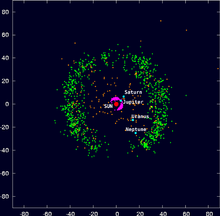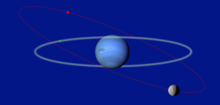Triton (moon)
Triton, or Neptune I, is the largest moon of the planet Neptune.[1][2] It is the seventh-largest moon in the Solar System. Triton is slightly smaller than Earth's Moon. Triton has a complicated geological history: it is thought to have a young surface compared to the age of the Solar System itself.
 Voyager 2 photomosaic of Triton's sub-Neptunian hemisphere | |
| Discovery | |
|---|---|
| Discovered by | William Lassell |
| Discovery date | October 10, 1846 |
| Designations | |
| MPC designation | Neptune I |
| Pronunciation | /ˈtraɪtən/ |
Named after | Τρίτων Trītōn |
| Adjectives | Tritonian |
| Orbital characteristics | |
| 354,759 km | |
| Eccentricity | 0.000016 |
| 5.876854 d (retrograde) | |
Average orbital speed | 4.39 km/s |
| Inclination | 129.812° (to the ecliptic) 156.885° (to Neptune's equator) 129.608° (to Neptune's orbit) |
| Satellite of | Neptune |
| Physical characteristics | |
Mean radius | 1,353.4±0.9 km |
| 23,018,000 km2 | |
| Volume | 10,384,000,000 km3 |
| Mass | (2.1390±0.0028)×1022 kg (0.00359 Earths) |
Mean density | 2.061 g/cm3 |
| 0.779 m/s2 (0.0794 g) (0.48 Moons) | |
| 1.455 km/s | |
| synchronous | |
Sidereal rotation period | 5 d, 21 h, 2 min, 53 s |
| 0 | |
| Albedo | 0.76 |
| Temperature | 38 K (−235.2 °C) |
| 13.47 | |
| −1.2 | |
| Atmosphere | |
Surface pressure | 1.4 to 1.9 Pa (1.38×10−5 to 1.88×10−5 atm) |
| Composition by volume | nitrogen; methane traces |





It was discovered by the British astronomer William Lassell on 10 October 1846, just 17 days after Neptune itself was discovered by the German astronomer Johann Gottfried Galle and Heinrich Louis d'Arrest.[1]
Triton is believed to be a captured Kuiper Belt object,[1] and is the coldest known body in the Solar System.[1] The surface temperature of Triton was recorded by Voyager 2 as -235 °C (-391 °F).[1] Triton has its own magnetic field and has a faint trace of an atmosphere.
Orbit
changeDrag and tidal interaction cause Triton to fall slowly into lowered orbits. This process is very slow. 3.6 billion years from now, Triton will pass within Neptune's Roche limit.[3] It will either collide with Neptune's atmosphere or break up, forming a ring system similar to that found around the planet Saturn.[3]
The reason why Triton is thought to be a captured object is its orbit, which is unique in the Solar System. It is both retrograde (see diagram) and highly tilted. Although there are other satellites with retrograde orbits, they are much smaller than Triton, and much more distant from their host planets (their "primaries"). Triton, like our Moon, shows only one face to the planet: it rotates in synchrony to Neptune.
Surface
changeAll we know about the surface of Triton comes from one fly-by of Voyager 2 in 1989. There are few impact craters. This suggests the surface is quite young in astronomical terms: estimates are six to 50 million years.[4]
Despite its very cold temperature, the surface of Triton is geologically active. There are events which look like geysers, volcanos and earthquakes. All the materials involved are quite different from those on Earth. Most of the gases are frozen most of the time. Gases like nitrogen are frozen until something occurs to melt them, then it turns back into a gas. A temperature increase of just 4 K (7.2 °F) is enough to make this happen.
Past formation and capture
changeLike most TNOs, Triton is mostly icy. While Triton's orbit does help us understand its past, it is mostly unknown. It is thought that Triton formed in a binary system, like Pluto, and was moving at very high speeds. However, when it passed through Neptune's Hill sphere the other body will have been flung out, reducing Triton's speed and allowing it to be captured. Now, Triton is the most massive TNO to ever have existed, and it had effects on Neptune's moon system. All large moons were destroyed, flung out of orbit or crashed into Neptune itself.
References
change- ↑ 1.0 1.1 1.2 1.3 1.4 "NASA: Solar System Exploration: Planets: Neptune: Moons: Triton". NASA. Archived from the original on 2011-02-19. Retrieved 2011-03-29.
- ↑ "BBC Home: Science: Space: Solar System: Moons: Triton". BBC. Archived from the original on 2011-08-31. Retrieved 2011-03-29.
- ↑ 3.0 3.1 Chyba C.F; Jankowski D.G. & Nicholson P.D. (1989). "Tidal evolution in the Neptune-Triton system". Astronomy and Astrophysics 219 (1–2): L23–L26. [1]
- ↑ Schenk, Paul M. & Zahnle, Kevin (2007). "On the negligible surface age of Triton". Icarus 192 (1): 135–49. [2]
Other websites
change- Triton Profile Archived 2011-02-19 at the Wayback Machine
- Triton Archived 2016-10-26 at the Wayback Machine